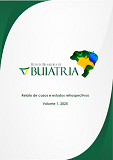criados em pastagens de trigo de duplo propósito

Carlos Bondan, Renato Serena Fontaneli, Giovani Faé e Ricardo Zanella
A raça bovina Wagyu, originária do Japão, é amplamente reconhecida pela sua qualidade de carne, caracterizada por um
alto teor de gordura intramuscular, conhecido como marmoreio. Esse diferencial confere à carne Wagyu um sabor único
e uma textura extremamente macia, tornando-a uma das mais valorizadas no mercado mundial. No entanto, para a
obtenção desta carne é necessário o uso de uma dieta nutricional específica, existindo ainda poucas pesquisas sobre a
utilização de sistemas de pastagem na criação desses animais. Diante disso, este estudo teve como objetivo avaliar os
efeitos de diferentes sistemas de pastagem de inverno sobre o desempenho zootécnico e a composição de carcaça de
bovinos Wagyu Kuroge. Para tal, doze touros Wagyu de sangue puro, com doze meses de idade, foram distribuídos em
três grupos, cada um alimentado com uma variedade distinta de trigo: BRS Tarumã (G1), BRS Tarumaxi (G2) e BRS
Pastoreio (G3). A análise estatística dos dados foi realizada no software R, utilizando ANOVA para verificar os efeitos
das dietas sobre as características produtivas dos animais. Os resultados indicaram que, embora o grupo G1 tenha
demonstrado uma tendência (P= 0,56) de maior ganho de peso vivo (1,96 kg/dia), não foram observadas diferenças
estatisticamente significativas entre os grupos em relação às características de carcaça (AOL, ESG, EGP e IMF),
possivelmente devido ao tamanho reduzido da amostra. No entanto, a interação entre o efeito genético paterno e a variedade
de trigo influenciou significativamente a composição de gordura intramuscular (P < 0,02). Com base nesses
achados, as pastagens de inverno demonstram potencial como alternativa alimentar viável para a criação de bovinos
Wagyu, podendo contribuir para a sustentabilidade dos sistemas de produção dessa raça.
Palavras-chave: carcaça, marmoreio, pastagem de inverno, Wagyu.
The Wagyu cattle breed, originally from Japan, is widely recognized for its meat quality, characterized by a high intramuscular fat content known as marbling. This difference gives Wagyu meat a unique flavor and an extremely tender texture, making it one of the most valued in the world market. However, to obtain this meat, a specific nutritional diet is necessary, and there is still limited research on the use of pasture systems in raising these animals. This study aimed to evaluate the effects of different winter pasture systems on the zootechnical performance and carcass composition of Wagyu Kuroge cattle. To this end, twelve purebred Wagyu bulls, twelve months of age, were distributed into three groups, each fed with a different variety of wheat: BRS Tarumã (G1), BRS Tarumaxi (G2), and BRS Pastoreio (G3). Statistical analysis of the data was performed using R software and ANOVA to verify the effects of the diets on the productive characteristics of the animals. The results indicated that, although group G1 demonstrated a tendency (P = 0.56) of greater live weight gain (1.96 kg/day), no statistically significant differences were observed between the groups regarding carcass characteristics (AOL, ESG, EGP, and IMF), possibly due to the reduced sample size. However, the interaction between the paternal genetic effect and the wheat variety significantly influenced the intramuscular fat composition (P < 0.02). Based on these findings, winter pastures demonstrate potential as a viable feed alternative for raising Wagyu cattle and may contribute to the sustainability of this breed's production systems.
Keywords: carcass, marbling, Wagyu, winter pasture.
1. MOTAYAMA, A. et al. Wagyu and the factors contributing to its beef quality: overview. Meat Science, v.120, p.64-71, 2016.
2. VÁZQUEZ-MOSQUERA, J.M. et al. Comparison of pure and crossbred japanese black steers in growth performance and metabolic features from birth to slaughter at a Spanish fattening farm. Animals, v.12, n.13, 1671, 2022.
3. ABCBRW. ASSOCIAÇÃO BRASILEIRA DOS CRIADORES DE BOVINOS DA RAÇA WAGYU. Histórico - Genética especial do Japão, 2019.
4. DEL DUCA, L.J. et al. Uso de trigo de duplo propósito na alimentação de bovinos: impacto sobre a qualidade da carcaça. Revista Brasileira de Zootecnia, v.29, n.3, p.345-357, 2000.
DEL DUCA, L.J. et al. Resultados da experimentação de genótipos de trigo para aptidão a duplo propósito no Paraná, em 2000. Embrapa Trigo - Boletim de Pesquisa Desenvolvimento, n.6, p.1-44, 2001.
5. DEL DUCA, L.J.A. et al. Experimentação de genótipos de trigo e outros cereais de inverno em semeadura antecipada para produção de grãos e duplo propósito no Rio Grande do Sul, em 2002. Embrapa Trigo. Documentos Online, n.30, p.1-21, 2003.
6. CASTRO, R.L. et al. BRS Pastoreio: nova cultivar de trigo duplo propósito da Embrapa. In: REUNIÃO DA COMISSÃO BRASILEIRA DE PESQUISA DE TRIGO E TRITICALE, 10., 2016, Londrina. Anais... Londrina: Comissão Brasileira de Pesquisa de Trigo e Triticale, 2016. p.5
7. SOUSA, C.N.A.; CAIERÃO, E. Cultivares de Trigo Indicadas para Cultivo no Brasil e Instituições Criadoras. 2ª ed. Brasília: Embrapa, 2014. 138p.
8. CASTRO, R.L. et al. BRS Tarumaxi: nova cultivar de trigo para pastejo. In: REUNIÃO DA COMISSÃO BRASILEIRA DE PESQUISA DE TRIGO E TRITICALE, 14., 2021, Castro. Anais... Castro: Fundação ABC: Passo Fundo: Biotrigo Genética, 2021. p.394-397.
9. SILVA, L.S. et al. Manual de Calagem e Adubação para os Estados do Rio Grande do Sul e de Santa Catarina. 11ª ed. Santa Maria: Pallotti, 2016. 376p.
10. MANNETJE, L.; JONES, R.M. Field and Laboratory Methods for Grassland and Animal Production Research. Wallingford: CAB International, 2000. 464p.
11. HAYDOCK, K.P.; SHAW, N.H. The comparative yield method for estimating dry matter yield of pasture. Australian Journal of Experimental Agriculture and Animal Husbandry, v.15, n.76, p.663-670, 1975.
12. GOTOH, T. et al. The japanese Wagyu beef industry: current situation and future prospects - A review. Asian-Australasian Journal of Animal Sciences, v.31, n.7, p.933-950, 2018.
13. SUGUISAWA, L. et al. Genetic selection and marbling in beef cattle: a review on Wagyu influence. Animal Genetics Research, v.45, n.2, p.112-120, 2013.
14. NEVES, A.L.A. et al. Impact of feed composition on rumen microbial dynamics and phenotypic traits in beef cattle. Microorganisms, v.13, n.2, p.310, 2025.
15. PARK, S.J. et al. Genetic, management, and nutritional factors affecting intramuscular fat deposition in beef cattle - A review. Asian-Australasian Journal of Animal Sciences, v.31, n.7, p.1043-1061, 2018.
16. WEST, M.H. et al. Herbage mass, nutritive value, and grain yield of four wheat varieties managed as a dual-purpose crop. The Journal of Animal Science, v.101, Suppl 1, p.51, 2023.
17. LEE, M.A. et al. Forage quality declines with rising temperatures, with implications for livestock production and methane emissions. Biogeosciences, v.14, n.6, p.1403-1417, 2017.
18. SNIFFEN, C.J. et al. A net carbohydrate and protein system for evaluating cattle diets: II. Carbohydrate and protein availability. Journal of Animal Science, v.70, n.11, p.3562-3577, 1992.

